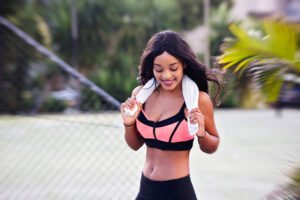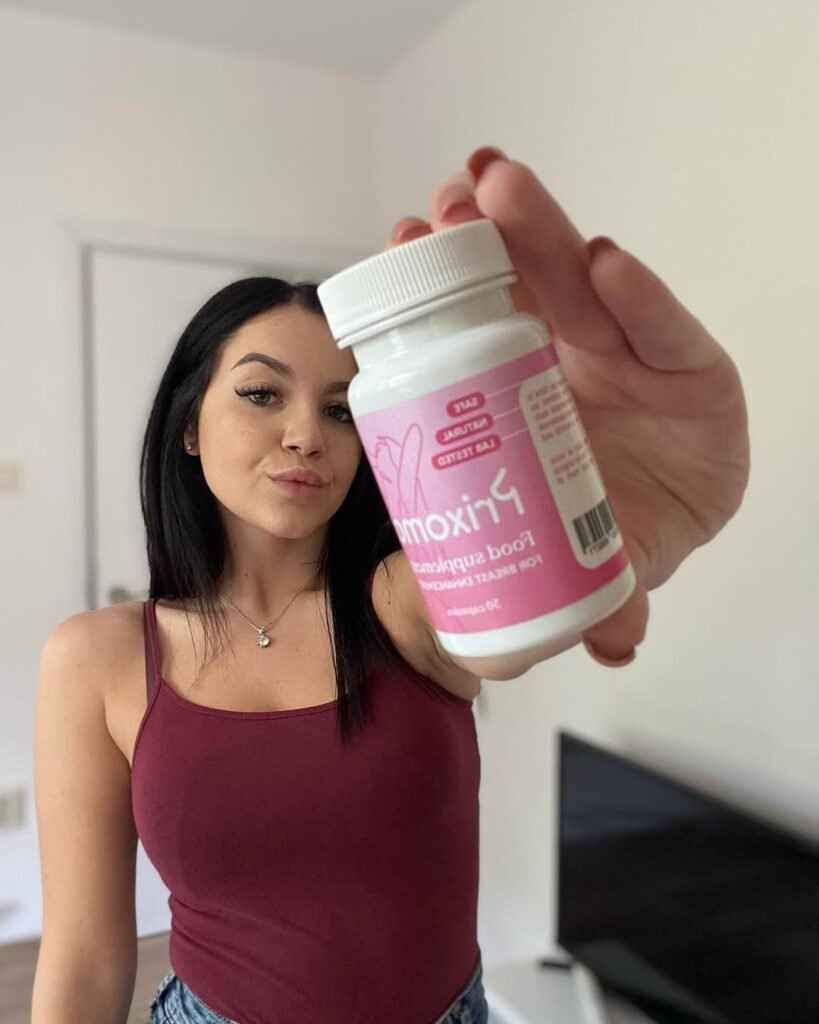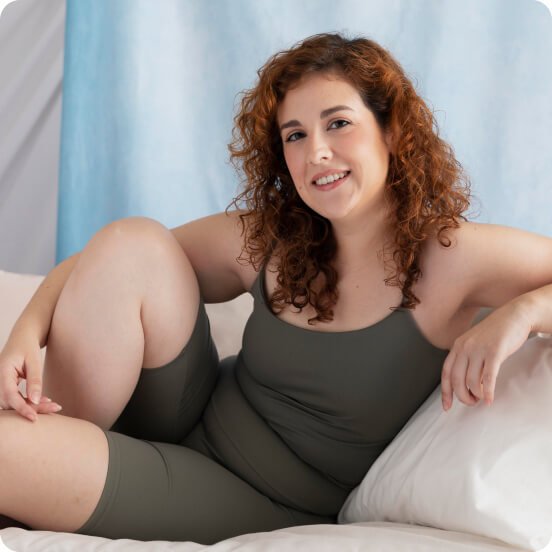Written by Gabrielle Kassel and medically reviewed by Danielle Hildreth, RN, CPT
Natural supplements promising breast enhancement have been growing in popularity as women increasingly seek safer, non-invasive alternatives to surgery. One supplement catching my personal and other women’s attention lately is Prixoma, which claims to improve breast size, firmness, and overall shape using purely natural ingredients. But does it actually work? Let’s check what’s inside Prixoma capsules and their potential benefits from a scientific perspective.
Understanding Breast Enhancement Naturally
Breast tissue size and firmness largely depend on genetics, hormonal balance, skin health, and overall nutritional status. Natural supplements like Prixoma contain ingredients known as phytoestrogens – plant-derived compounds that mimic the action of estrogen and progesterone in the body, stimulating breast growth and fullness. Additionally, ingredients that enhance blood circulation, collagen production, and skin elasticity can further help to improve breast look.
What’s Inside Prixoma?
Prixoma contains 11 selected natural ingredients, each chosen for their scientifically backed or traditionally validated roles in female hormonal health and breast enhancement:
- Saw Palmetto Fruit Extract (4:1): Traditionally used to balance hormones, specifically by reducing androgenic activity. Studies suggest that saw palmetto promotes breast growth by creating favorable hormonal conditions (Debruyne et al., 2002).
- Fenugreek Seed Extract (4:1): Rich in diosgenin, fenugreek has demonstrated significant estrogenic activity in various studies. Clinical trials suggest fenugreek supplementation leads to increased breast size and fullness (Steels et al., 2017).
- Motherwort Flowering Top Extract (4:1): Known in traditional herbal medicine for supporting female reproductive health and circulation. Improved circulation contributes to breast tissue health and firmness.
- Fennel Seed Extract (4:1): Contains potent phytoestrogens like anethole, which have shown estrogenic properties. Research supports fennel’s ability to stimulate breast tissue development (Albert-Puleo, 1980).
- Blessed Thistle: Traditionally used for lactation support, blessed thistle has historically been used for breast enlargement and female hormonal balance, with evidence suggesting enhanced breast fullness.
- L-Tyrosine: An amino acid critical for the synthesis of dopamine and norepinephrine, essential neurotransmitters involved in hormonal regulation. L-Tyrosine supplementation has shown benefits in hormonal balance and overall endocrine function (Fernstrom & Fernstrom, 2007).
- Kelp Powder: High in iodine, kelp supports thyroid function, which is crucial for hormonal balance. Proper thyroid function is linked to balanced estrogen levels, necessary for healthy breast tissue maintenance.
- Dong Quai Root Extract (1% ligustilide): Widely recognized in traditional Chinese medicine as a hormone balancer and circulation enhancer. Clinical research indicates that Dong Quai effectively balances female hormones and improves circulation, benefiting overall breast health (Circosta et al., 2006).
- Red Clover Extract (20:1): Contains potent isoflavones, powerful phytoestrogens. Clinical trials have demonstrated improvements in breast density and tissue health through red clover supplementation (Atkinson et al., 2004).
- Chaste Fruit Extract (Vitex Agnus Castus): Clinically validated for hormonal regulation, especially progesterone and estrogen balance. Studies have consistently demonstrated its effectiveness in supporting breast health and hormonal conditions such as premenstrual syndrome (Roemheld-Hamm, 2005).
- Black Cohosh Rhizome Extract (2.5% triterpene glycosides): Historically used to manage menopausal symptoms due to its phytoestrogenic activity. Clinical trials suggest black cohosh supports breast tissue firmness and overall female hormonal balance (Mahady, 2005).
Do These Ingredients Really Work?
Scientific and traditional evidence strongly suggests that many of Prixoma’s ingredients possess estrogen-like activities that promote breast enhancement. Ingredients such as fenugreek, fennel, red clover, and black cohosh have documented effects on breast tissue through phytoestrogenic pathways. Moreover, herbal extracts like saw palmetto and chaste fruit are scientifically supported for balancing hormones that significantly impact breast tissue growth and health.
It is important to note that natural breast enhancement is gradual, typically becoming noticeable within 1-3 months of consistent use. Results vary based on individual hormonal balance, metabolism, and lifestyle factors.
Safety and Side Effects
Prixoma is vegan-friendly, gluten-free, and non-GMO, aligning with the preferences of health-conscious consumers. Generally, Prixoma’s ingredients are safe and well-tolerated. However, minor digestive symptoms can occasionally occur when starting the supplement. Prixoma is not recommended for women under 18, pregnant, or breastfeeding.
Final Thoughts: Should You Try Prixoma?
Considering the available scientific and traditional evidence, Prixoma appears to be a scientifically plausible natural method for enhancing breast fullness, firmness, and overall shape. Its blend of phytoestrogen-rich botanicals and supportive nutrients provides a comprehensive approach to natural breast enhancement. For women seeking safe, non-invasive alternatives to surgery, Prixoma is certainly a supplement worth exploring. As always, consistency, patience will deliver the best outcomes.
As mentioned, Prixoma’s ingredients have a solid scientific background and they are shown in multiple studies to work. In simpler words I would say that Prixoma definitely has potential for enhancing your breasts.
About The Author
Gabrielle Kassel (she/her) is a queer sex educator and wellness journalist who is committed to helping people feel the best they can in their bodies. Her work has appeared in publications such as Shape, Cosmopolitan, Well+Good, Health, Self, Women’s Health, Greatist, and more! In her free time, Gabrielle can be found coaching CrossFit, reviewing pleasure products, hiking with her border collie.
Danielle Hildreth is a registered nurse and certified personal trainer. She works full time in a labor and delivery unit, and her fitness background includes personal training, HIIT, yoga sculpt, and dance. Beloit College, BA. University of Illinois Chicago, MSN.
References
- Debruyne, F., et al. (2002). Therapeutic potential of saw palmetto in androgen disorders. European Urology.
- Steels, E., et al. (2017). Clinical evaluation of fenugreek seed extract on breast size. Phytotherapy Research.
- Albert-Puleo, M. (1980). Fennel and anise as estrogenic agents. Journal of Ethnopharmacology.
- Fernstrom, J.D., & Fernstrom, M.H. (2007). Tyrosine and brain function. Journal of Nutrition.
- Circosta, C., et al. (2006). Effects of Angelica sinensis (Dong Quai) on hormonal regulation. Phytotherapy Research.
- Atkinson, C., et al. (2004). Effects of red clover isoflavones on breast density. Journal of Clinical Endocrinology & Metabolism.
- Roemheld-Hamm, B. (2005). Chasteberry for premenstrual syndrome. American Family Physician.
- Mahady, G.B. (2005). Black cohosh for menopause symptoms. Menopause.
















